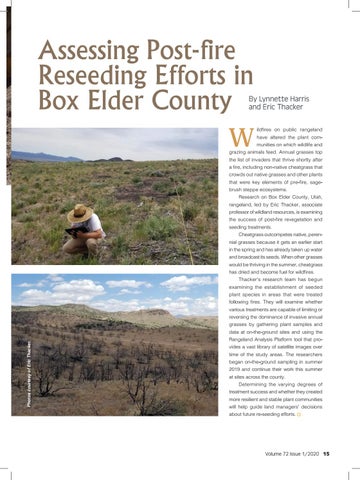Assessing Post-fire Reseeding Efforts in Box Elder County W
By Lynnette Harris and Eric Thacker ildfires on public rangeland have altered the plant communities on which wildlife and
grazing animals feed. Annual grasses top
the list of invaders that thrive shortly after a fire, including non-native cheatgrass that
crowds out native grasses and other plants that were key elements of pre-fire, sagebrush steppe ecosystems.
Research on Box Elder County, Utah,
rangeland, led by Eric Thacker, associate
professor of wildland resources, is examining
the success of post-fire revegetation and seeding treatments.
Cheatgrass outcompetes native, peren-
nial grasses because it gets an earlier start in the spring and has already taken up water
and broadcast its seeds. When other grasses
would be thriving in the summer, cheatgrass has dried and become fuel for wildfires.
Thacker’s research team has begun
examining the establishment of seeded plant species in areas that were treated
following fires. They will examine whether various treatments are capable of limiting or reversing the dominance of invasive annual grasses by gathering plant samples and
Photos courtesy of Eric Thacker.
data at on-the-ground sites and using the Rangeland Analysis Platform tool that provides a vast library of satellite images over time of the study areas. The researchers
began on-the-ground sampling in summer 2019 and continue their work this summer at sites across the county.
Determining the varying degrees of
treatment success and whether they created
more resilient and stable plant communities will help guide land managers’ decisions about future re-seeding efforts. ¤
Volume 72 Issue 1/2020 15








